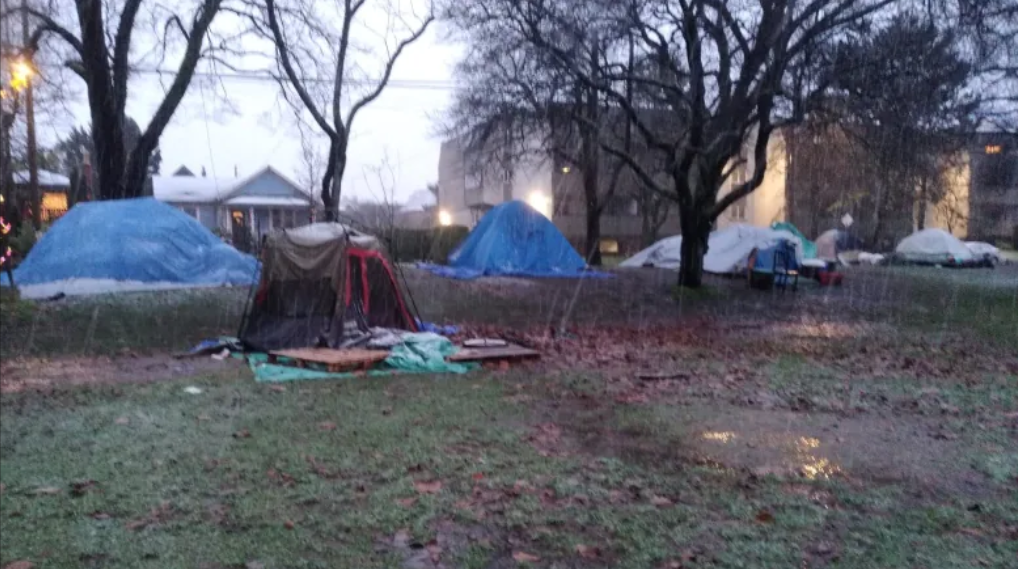Seasonal weather shelters late and inadequate, say advocates

As climate change worsens, winters in Victoria will get wetter and wetter. Atmospheric rivers, like the ones the province experienced in November, are expected to become more intense. This is bad news for members of Victoria’s unhoused community already dealing with soaked tents and lack of shelter space.
“They’re soaking wet constantly,” said Thea Hinks, an outreach worker for SOLID.
Following the extreme weather on Nov. 14 that left B.C.’s interior cut off from the rest of the province and Merritt, Princeton, and the Sumas Prairie underwater, the Greater Victoria Coalition to End Homelessness (GVCEH) began working to get Victoria’s extreme weather shelters up and running. The coalition expects the shelters to be functioning shortly, once they have hired enough staff.
GVCEH acknowledges that the province’s extreme weather response shelter is not prepared to deal with the impacts of climate change expected to hit Victoria over the coming years. This not only includes the heavy rain and flooding that the city is currently experiencing but also the hot, dry conditions experienced this summer during the heat dome.
“The extreme weather responses built into our system are every year, every winter, when we have the operational capacity to do it,” said GVCEH’s Communications Coordinator Nina Grossman. “It’s not necessarily the response that was in place for something like a huge flood.”
The need for shelter
In 2020, GVCEH estimated there were over 1 500 unhoused people in Greater Victoria. Over the past 18 months, the City of Victoria has moved over 600 people, who had been living in parks, into temporary shelters.
An agreement between the city and the province is expected to result in the completion of 280 units of permanent supportive and low-income housing in Greater Victoria.
Many of Victoria’s unhoused, however, remain outdoors where they are exposed to the elements. Wet, damp conditions increase the potential for sickness, and lack of sleep, according to the Canadian Medical Association.
Staffing shortages have prevented many shelters from opening their doors this winter, despite a continued and growing need.
The Victoria Native Friendship Centre, which usually operates a 25-bed shelter between November and May, still has multiple job postings open including for a team lead and coordinator. The Salvation Army, Our Place Society, and Cool Aid Society are also struggling to find people to run their housing supports and shelters.
Shelters that have opened struggle to meet the need for spaces. The Salvation Army has been able to get a 30-bed shelter up and running; however, they are still limited in the days they can open. This is not enough to accommodate the roughly 200 people living in tents across Victoria, an estimate made by PEERS Victoria Resource Society.
Help is on the way, however, as Victoria has triggered its emergency weather response and found shelter space at James Bay United Church.
Hinks says that this response by the city should have happened far sooner.
“There was no planning in September for this,” said Hinks. “Every year we go through this.”
With temperatures around freezing expected to persist over the next few weeks, Hinks says it is important to make sure people have space to stay warm and keep themselves dry. She also says it is important to make sure people are aware of the spaces available to them. So far, she has only heard about the shelters through CBC radio and the job-posting website Indeed.
Hinks says that many people living outdoors don’t have access to radio or the internet. She says that because of this, people aren’t showing up to shelters because they don’t know where they are or when they are open.
Floods and soaked belongings
In December 2020, Victoria’s Central Park flooded, affecting roughly 50 people living in tents at the site. Many of their belongings were damaged or destroyed and they were forced to move to the parking lot of Royal Athletic Park.
Consistent wet weather can force people living outdoors to dispose of the little clothing and supplies they have.
“Soaking wet, thrown in the garbage, or landfill gets filled up with perfectly good clothes,” Hinks said.
A recent report by the Capital Regional District says Victoria Harbour and the neighbourhood along the Gorge will be increasingly prone to flooding as a result of climate change.
While many of the high-risk areas included in the report, including much of the Gorge as well as Cadboro Bay and Oak Bay, are occupied by primarily wealthy residents, there is a significant number of unhoused people living by Victoria Harbour and at the southern end of the Gorge.
Around the world, climate change is expected to disproportionately impact already vulnerable people. This includes the unhoused, who are usually at greater risk during storms, heat domes, and other adverse weather events. Further, homelessness is a racialized issue. Roughly a third of all unhoused people in Greater Victoria are Indigenous.
Nikki Elliott, project manager for the Capital Regional District Flood Inundation Mapping Project, told the Martlet that the report is a preliminary step in creating an action plan to deal with the increased risk of storms and flooding. She says that municipal governments can take different approaches to acting on the report’s findings.
“This really was meant to be the data piece, as some local governments or some coastal stakeholders may need more detailed study,” Elliott told the Martlet. “It also gives some guidance that local governments, for example, should consider around where development occurs, and how high.”
For Grossman and the GVCEH, the priority over the coming years should be to make sure that all unhoused people are given a home, reducing their vulnerability to adverse weather events. She says that it is also important to consider how people are being impacted in our communities and to find ways of supporting them.
“Climate change, of course, it’s going to affect people disproportionately,” she said. “That’s not just inside of our country, that’s in our communities as well.”








